 Affiliate marketing payment methods constitute one of most important aspects you need to sort out before launching your affiliate program.
Affiliate marketing payment methods constitute one of most important aspects you need to sort out before launching your affiliate program.
They determine not only your financial obligations to your affiliates but also how potential affiliates will see your program. These terms are among the main criteria publishers will consider when deciding whether to join your program or not.
Therefore, when defining them, you’ll want to take into account both your interests, as a merchant, and those of your affiliates. As recommended in our previous post on competitive analysis, you should check out what your main competitors do as well. Your potential affiliates will surely compare you with them, so you’ll need a competitive edge here — something to make your program stand out, projecting affiliate-friendliness and attractiveness.
Now that you understand how important your affiliate program’s payment terms are, and how you should approach them, let’s take a closer look at the aspects they need to cover. You will have to make decisions related to:
- Payment models
- Payouts
- Incentives
- Locking period and reversals
- Payment thresholds, frequency, and methods
Payment Models
Choosing the best payment model for your business basically means choosing what type of actions driven by your affiliates to reward. You have four main options available: clicks (PPC), leads (PPL), sales (PPS), and calls.
As Geno warns in his Affiliate Management: An Hour a Day, unless you have an excellent tracking system in place that allows you to prevent fraud, you’ll want to avoid the pay-per-click payment model. This leaves you with three options. Let’s take them one by one and see what they involve.
1. Pay-per-Sale
Sales equal revenue, and it definitely makes sense to reward your affiliates for the revenue they drive. The pay-per-sale payment model involves paying your affiliates a percentage of the full sale amounts. It is up to you to determine the percentage.
Walmart is one of the merchants who use this payment model. They reward qualifying purchases by commissions ranging between 1% and 4% on most product categories but the commissions can reach 10-18% for sales on certain categories, like Contact Lenses and Business & Personal Checks.
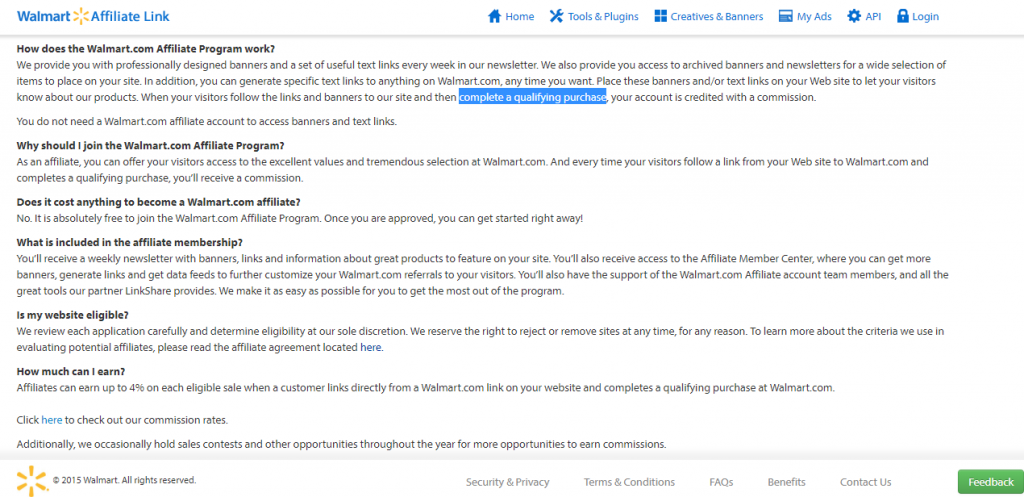
2. Pay-per-Lead
Sales may not be the only type of affiliate-driven actions your business benefits from. Free trials and newsletter subscriptions may be worth something as well. After all, once you’ve convinced potential clients to try your products or services and give you their contact details, turning them into paying customers should be easy.
One merchant who rewards leads is Gusto. As shown below, they pay $25+ for free trial leads on their payroll software. If your business could benefit from leads, you should consider rewarding them as well. Just be careful how you define leads to discourage fraud and fake leads that incentive affiliates may send in.
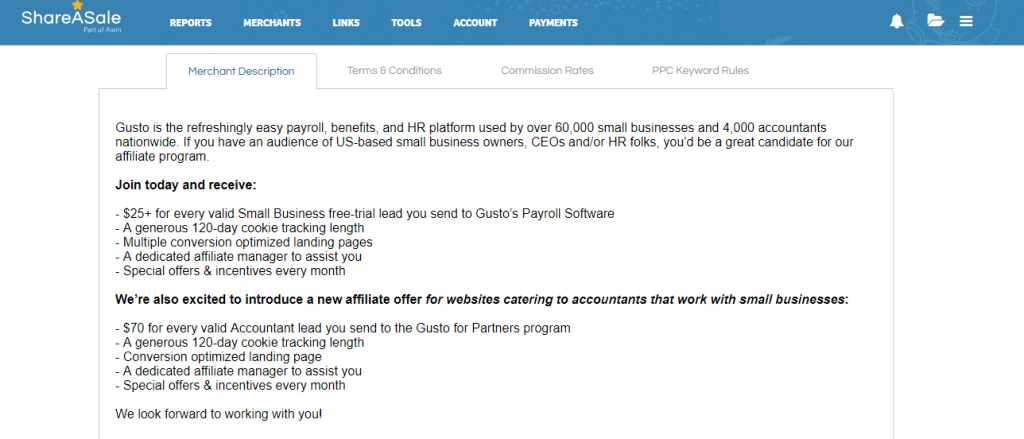
3. Pay-per-Call
This payment model works especially well for service companies, from real estate agents and home-improvement contractors to law firms and financial consultants. It is used by luxury goods providers (think diamonds, expensive watches, luxury cruises, and more) as well.
One merchant using the pay-per-call model is KGR Contractors (see screenshot below). Most merchants prefer to run their programs on dedicated pay-per-call networks like Invoca, RingPartner, and similar. If you decide to use this payment model, partner with a good pay-per-call platform which will support assigning trackable phone numbers to your affiliates.

Now that you have a better idea of the available payment models, choosing the best option for your business should be easy. Just keep in mind that you do not have to choose just one payment model. You can combine the two or three that work best for you.
4. Combined Payment Models
Many merchants reach the conclusion that they want to reward more than one type of action. Some, like the ones below, find it easy to turn leads and calls into sales, so it makes sense for them to reward those as well. One example of such merchant is Amazon. They reward both qualifying purchases (sales) and bounty actions (leads). The actions and commissions are all detailed here.
For National Debt Relief, calls and leads are the ones that count, since they have no ready-to-sell products. As you can see in the screenshot below, they also reward affiliates who refer new affiliates. This brings us to another decision you will have to make for your affiliate program payment terms:
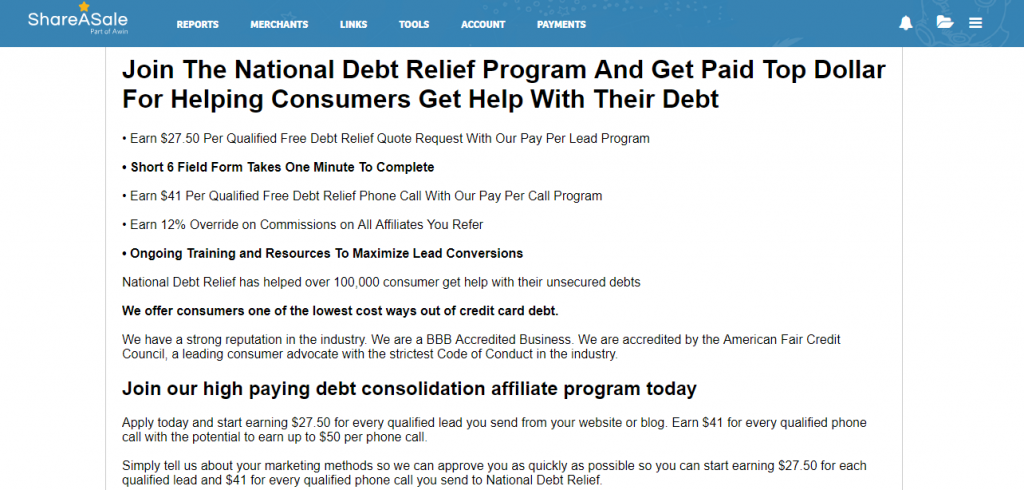
Do You Need a Two-Tier Affiliate Program?
A two-tier program may end up being a good way to finding more affiliates. So, it’s worth considering adding the element of second tier to your main program, allowing you to reward referred sign-ups of new affiliates.
If you feel that your business could benefit from a two-tier affiliate program, you should go for it. Just take your time when deciding how to reward referrals. A flat fee is usually preferable for merchants but it may not be enough for affiliates and does not guarantee the performance of the referred affiliate. A percentage of the referred affiliate’s commission may seem fair, but it could drive affiliates to refer themselves under different accounts only to earn higher commissions. Whatever you decide, it is important to anticipate possible issues and be ready to solve them in an affiliate-friendly way.
Cookie Life
In affiliate marketing, cookie life means the time period between the click on the affiliate site and the last day when you are willing to pay that affiliate a percentage of the sale made by “their” visitor. After that period, even if the consumer completes the purchase, the affiliate will no longer be remunerated for it.
Some merchants may think that setting a short cookie life is a viable solution to drive sales without paying for them. However, affiliates do take cookie life into account when deciding whether to join a program or not, and a short cookie life could deter them.
What would be a decent cookie life? One way of determining that would be to study analytics, see how long visitors following affiliate links needed to become paying customers, and add a few more days to that period.
Another way to decide would be to look at your main competitors and set a matching or a slightly longer cookie life. Or, you can follow Geno’s recommendation from Affiliate Management: An Hour a Day and set cookie life at 90 days, offering increases to 180 and, respectively, 365 days as an incentive for affiliates to activate.
Amazon, for example, has set cookie life at 24 hours. However, they extend it to a 90-days’ cookie life in situations when the customer ads the product to their cart but finalizes the purchase later.
The truth is that most website visitors complete their purchase(s) within the first days from clicking the affiliate link. Therefore, you lose nothing by setting a long cookie life. On the contrary, it may help you earn affiliates, considering that most publishers prefer programs with longer cookie life.
Payouts
Besides payment models and cookie life, your affiliate program payment terms need to specify the commissions you will pay to your affiliates. These are entirely up to you, and the best way to determine them is to analyze your own business, expenses, and profit margins. The following tips may come in handy:
- Look at what your competitors are offering and try to match or exceed their offer.
- Remember that, besides affiliate commissions, you will also have to cover the other costs of running your affiliate marketing program.
- If you have numerous products or services, feel free to differentiate commissions according to categories, sellability, and profit margins.
- It is never a good idea to start with a high commission only to discover that you cannot afford to pay it and be forced to lower it.
- To motivate affiliates, consider offering them tiered increases, according to their performance.
For example, Amazon pays commissions ranging from 0 to 10% according to product category. They also pay bounty fees ranging from $3 to $15, and 4% on trade-in events from specific categories. Walmart has a similar approach to sales, rewarding them with commissions between 1% and 18% (you may see these two programs compared here).
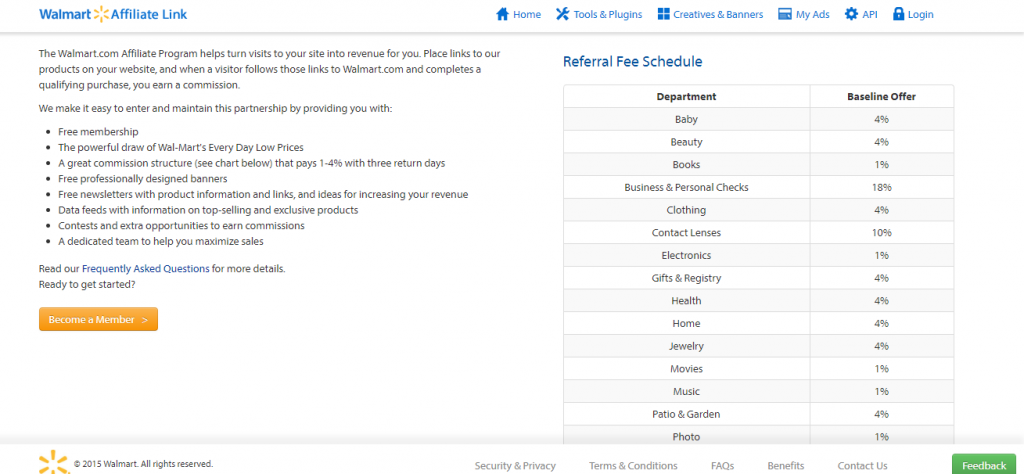
Other merchants pay a fixed commission which can reach up to 50% of the generated sale. To make sure you pay your affiliate fairly and avoid having to lower payments later, consider calculating 50% of your profit margin and using that value as the highest limit.
Should you somehow find yourself forced to lower commissions, consider applying the new, lower commissions to new affiliates only, and maintaining the same payment levels for existing affiliates. And, as Geno suggested, don’t hesitate to motivate your affiliates to sell more.
Affiliate Incentives
If you want your affiliates to actively promote your products or services, you should not only reward their efforts but also encourage them to perform better. And while monetary rewards should not be your only way of activating and motivating affiliates, they definitely have their well-deserved place.
There are three main ways to reward and motivate affiliates. Before we take a closer look at them, keep in mind that the terms of your incentives offer are entirely up to you. You can offer only one, combine two, or all three types of incentives.
Also, you can offer them on a monthly basis or on special occasions only. Finally, you can keep offering them to an affiliate once they’ve earned them, or you can “reset the counter” and ask your affiliates to repeat the performance if they want to continue receiving their incentives.
For best results, take the time to clearly define the incentives and the qualifying actions in your payment terms. You want your affiliates to know exactly what the bonus is, how much time they have available, and what they have to do in order to obtain it. Here are the mentioned three types of incentives:
1. Commission Increases
You can set sales thresholds at which to increase the commission your affiliates can earn. If your standard commission is 10%, you can increase it to 12.5% for affiliates who drive more than 2,500 sales and to 15% for affiliates driving more than 5,000 sales, etc.
This is the approach we took in NECTAR Sleep‘s affiliate program, and, along with other affiliate-friendly decisions, it helped them become the top merchant on ShareASale. See screenshot of their tiered payment terms highlights below.
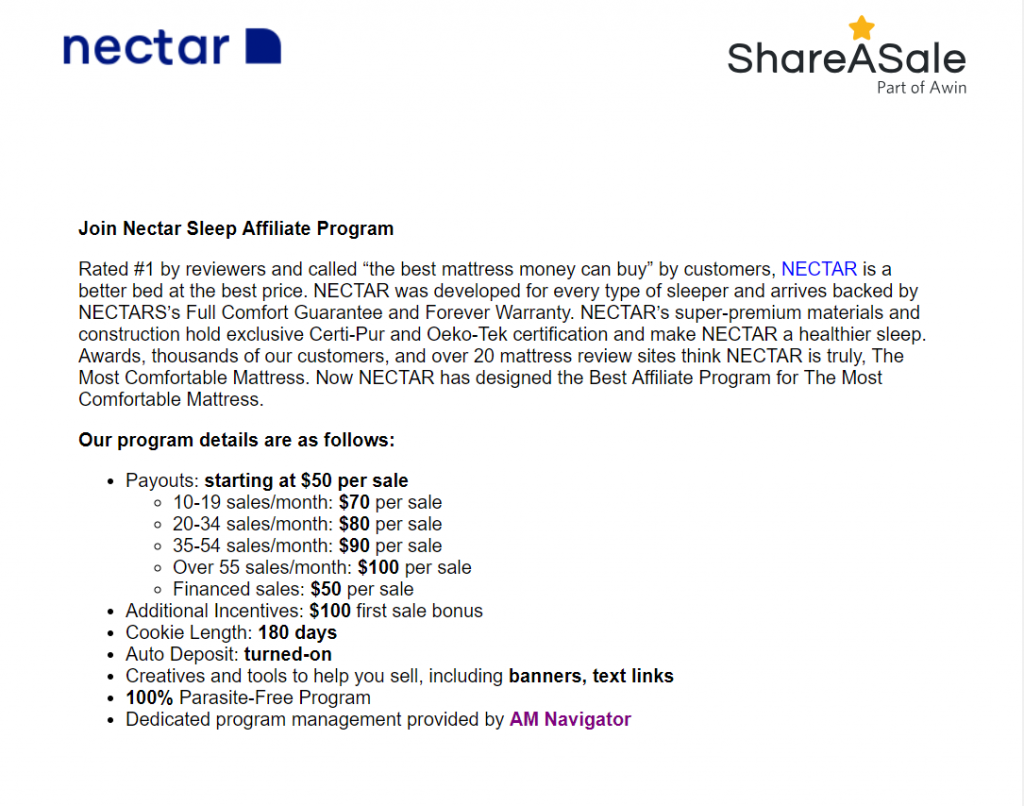
2. Cash Bonuses
When you cannot afford or do not want to increase the commission you pay to your affiliates but you still want to reward and encourage performance, you can set fixed cash bonuses. For example, you can pay $100 on every 1,000 sales referred, or reward affiliates who drive 10 leads within one-month of joining your program with $50 on top of the standard commissions earned.
It is worth pointing out that it’s not an “either… or…” situation, but you may definitely offer both performance-based payout increases, and cash bonuses. See the NECTAR Sleep’s affiliate program description referenced above.
3. Prizes
When you do not want to get more money out of your pocket, perhaps there are certain products or services you can offer as prizes. Think of electronics, gift certificates, event tickets, cruises, and more. They can be products from your own inventory, items you already have and can part with, or stuff you can get at convenient prices. Of course, if you want your affiliates to respond, you will have to choose attractive prizes.
Commission increases, cash bonuses, and prizes can be offered to all affiliates who meet the related-conditions or to the first ones who do. In this last case, you basically organize affiliate contests. At AM Navigator, we have been proposing and organizing affiliate contests since 2007. For more information on this method, read Geno’s post on how to make extrinsic motivators work.
Now you know what type of actions to reward, how much to reward them by, and how to motivate your affiliates. However, your affiliate program payment terms need to cover two more important aspects, discussed below.
Locking Period and Reversals
Do you have many customers who cancel their orders or ask for refunds? Depending on your answer to this question, you’ll need to set a locking period for the transactions your affiliates drive. This period is basically a waiting period you give yourself in order to determine if an action qualifies for a payout or not.
It is up to you to decide whether or not you reward sales that are canceled or reversed. When making this decision, you should honestly assess why the occasional reversals occur. They may have nothing to do with your affiliates and be the result of your products’ or services’ poor quality. If that is the case, your affiliates should not suffer.
However, there are also circumstances where affiliates mislead consumers into buying and the latter end up requesting refunds. When that happens, as a merchant, the least you can do is to retain the commission you would pay for a final sale. Depending on how clearly you defined qualifying purchases and affiliate rights and obligations, further measures may be necessary.
Returning to the locking period, Walmart and many other merchants have a 60-day policy. It should be more than enough for you as well. A longer locking period may discourage publishers, so try not to exceed the two-month threshold. Speaking of thresholds, you’ll need to set some for the payments you make.

Payment Thresholds, Frequency, and Methods
These may seem like insignificant details but, if you want to avoid misunderstandings with your affiliates, it helps to clarify them in the payment terms. Many merchants set a minimum limit for the commissions they pay to their affiliates.
For example, Amazon has a $10 minimum threshold for affiliates choosing to get paid by direct deposit or gift card, and a $100 threshold for payments by check. Affiliates who do not reach the threshold will have their payments rolled over to the following month until they do.
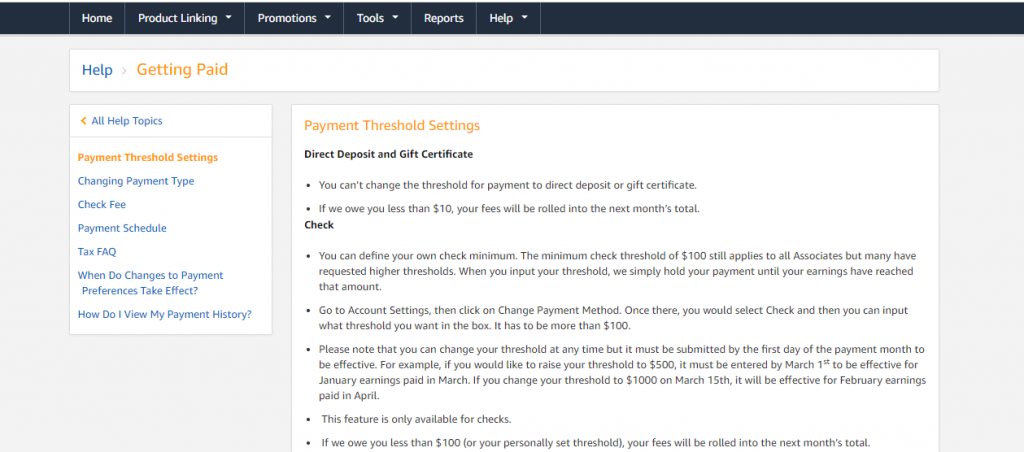
When setting your thresholds, make sure they don’t become an obstacle for your affiliates to get paid. A threshold of $10-25 is acceptable. One of $100 or $500 could be considered too high (and, therefore, demotivating). Besides setting minimum thresholds for payments, you will also have to decide on the frequency and payment methods.
You can make weekly payments to your affiliates if you choose to. However, to avoid tracking issues and fees, we recommend monthly payments, preferably on the same day of the month. This will give your affiliates a sense of financial security.
As far as methods are concerned, you’ll obviously want to settle on the ones that are most convenient for you while also paying attention to your affiliates’ needs. Direct deposits are a must. Gift cards make an excellent option but they should not be the only one available. Many affiliates prefer the convenience of systems like PayPal or Payoneer, so, if you can, try to take their preferences into account.
Final Recommendations on Affiliate Payment Terms
As mentioned on several occasions, the best way to make affiliate program-related decisions is to look at things from your affiliates’ perspective as well. It will help you keep your program attractive to publishers while you pursue your own interests.
We’ve already discussed the main aspects your affiliate program payment terms will have to cover. Now it is up to you to draw the line and finalize the details. If you encounter any difficulties, we’re here to guide you in the right direction. Drop a comment below or contact us and we’ll get back to you with the answers you need as soon as possible!
Thanks for sharing these tips. Interesting note about Gusto. In my experience, it’s really hard to make pay-per-leads work for payroll software, but this was also years and years ago, so I’m sure a lot has changed.
Hi, Alice! Good point. I think pay-per-lead can work on software, including payroll, but its effectiveness will depend on how the program is managed. With clear rules and policies in place (including a thorough definition of qualifying leads) and active management (reviewing and approving affiliates individually, monitoring their activity, policing them, etc.) it can work.
Of course, I would make such a decision on a case-to-case basis, after testing and/or carefully reviewing the software, and I would create the rules accordingly. I don’t believe in universal solutions.
Without a sound program agreement and active management, pay-per-lead is indeed dangerous. Any software merchant could end up paying a fortune on fake leads. That’s what agencies like ours are trying to prevent.
Hi. Great article. I am wanting to start my own affiliate program for a product I wish to sell. What software is available out there for a beginner? Regards,
Hi, Doug! Thank you for reaching out. Would you mind giving us a few more details about your product so that we can assess your needs? You can email them to info@amnavigator.com and we’ll get back to you with an answer as soon as possible.